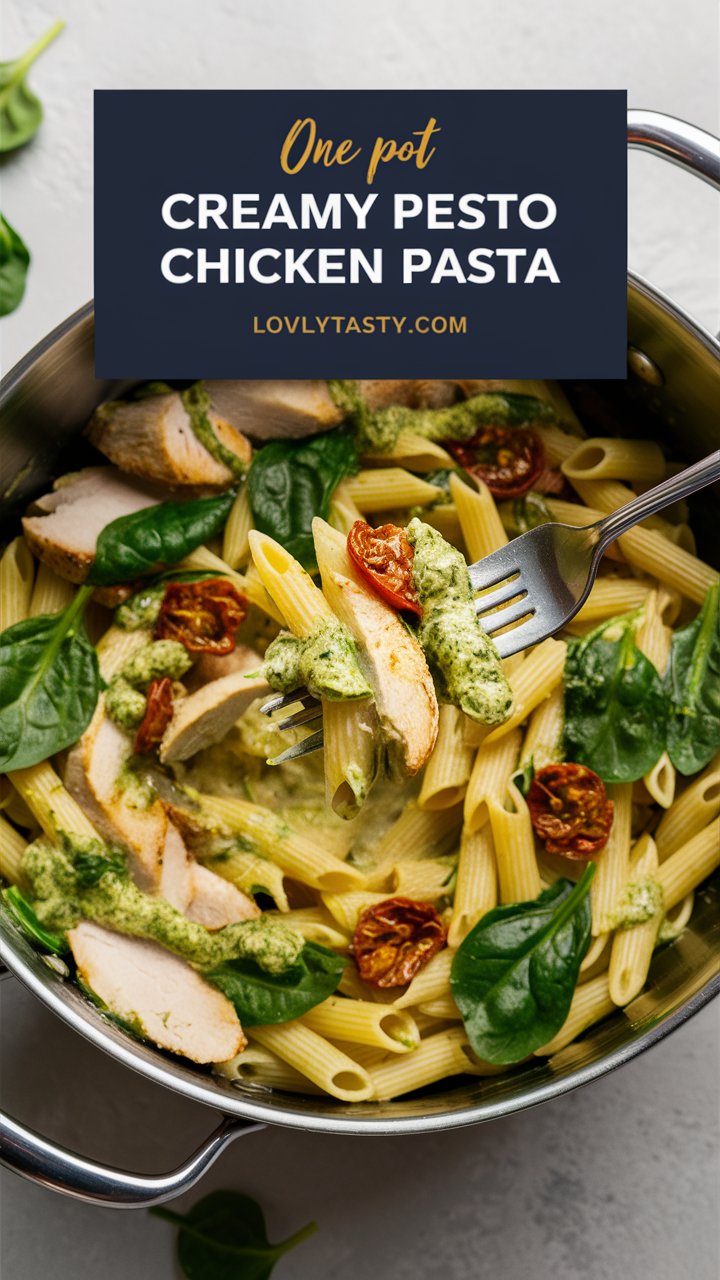
How to Make Restaurant-Quality Creamy Pesto Chicken Pasta at Home 2025
Few dishes deliver the cozy satisfaction of a creamy pasta while still tasting light and vibrant. Creamy Pesto Chicken Pasta achieves that perfect balance: juicy pan-seared chicken, a luxuriously silky cream sauce infused with basil pesto, and crisp-tender asparagus all tossed with ribbons of al dente fettuccine.
This comprehensive guide goes far beyond a simple recipe. Here you’ll discover the why behind each step, expert tips for flawless results, creative ingredient swaps, nutritional insights, and make-ahead strategies so you can adapt the dish to any occasion. Whether you are a busy parent, a beginner home cook, or a seasoned foodie, this article will walk you through everything you need to create a restaurant-worthy dinner in your own kitchen.
1. Introduction: Why Creamy Pesto Chicken Pasta Is a Modern Classic
Pasta dishes are timeless, but this one stands out because it marries comfort and freshness in a single pan.
Comfort comes from the luxurious cream sauce, gentle garlic undertones, and the satisfying chew of fettuccine.
Freshness shines through basil pesto and seasonal vegetables like asparagus, which cut through richness with bright herbal and green flavors.
This dual personality makes the dish remarkably versatile:
- Weeknight Efficiency: Ready in about 30 minutes when prepped efficiently.
- Dinner-Party Elegance: The vibrant green sauce and golden seared chicken look worthy of a bistro plate.
- Year-Round Appeal: Fresh asparagus in spring, baby spinach in winter, cherry tomatoes in summer—you can adapt to whatever looks best at the market.
With the right technique, you’ll achieve a dish that’s indulgent yet balanced—exactly the kind of recipe that impresses without stress.
2. Key Ingredients and Their Culinary Roles
A great dish starts with great ingredients. Understanding why each component matters will help you shop wisely and make smart substitutions.
Chicken Breast
- Why It Works: Lean protein that sears beautifully and absorbs sauce flavors.
- Pro Tip: Choose evenly thick boneless, skinless breasts, or butterfly thicker ones to ensure quick, even cooking.
Fettuccine
- Why It Works: The wide, flat noodles cling to creamy sauce better than thinner spaghetti.
- Alternatives: Linguine or tagliatelle for similar texture; gluten-free pasta for dietary needs.
Asparagus
- Why It Works: Adds a pleasant snap and earthy sweetness.
- Seasonal Swaps: Broccoli florets, green beans, or baby zucchini when asparagus is out of season.
Basil Pesto
- Why It Works: Delivers concentrated basil flavor, garlic, Parmesan, and olive oil in one spoonful.
- Quality Counts: Use a freshly made pesto or a reputable refrigerated brand. Jarred shelf-stable pesto can work but often needs an extra squeeze of lemon to brighten the flavor.
Heavy Cream
- Why It Works: Creates the luscious body of the sauce and tempers the strong basil and garlic notes.
- Lighter Options: Half-and-half or whole milk plus a little grated Parmesan can be used if you prefer a lighter dish, though the sauce will be thinner.
Olive Oil & Aromatics
High-quality olive oil builds flavor as you sear the chicken and sauté the vegetables. A touch of minced garlic or a shallot can be added to deepen the aroma without overpowering the pesto.
Parmesan Cheese
Though technically optional, a shower of freshly grated Parmesan at the end adds nutty, salty complexity.
3. Step-by-Step Cooking Instructions with Professional Tips
Below is a detailed walkthrough to ensure flawless results, including timing, texture cues, and chef-level advice.
Step 1: Prep Like a Pro
- Trim the Asparagus: Snap or cut just above the woody ends. Slice into 2-inch pieces.
- Slice Chicken: Halve large breasts horizontally to create thinner cutlets for faster cooking.
- Season Generously: Pat the chicken dry, then sprinkle with about ½ teaspoon salt and ¼ teaspoon black pepper per pound.
Chef’s Note: Dry surfaces sear better. Moisture creates steam, preventing the golden crust that develops flavor.
Step 2: Cook the Pasta
- Bring a large pot of well-salted water to a rolling boil.
- Add 12 ounces of fettuccine and cook until just al dente, usually one minute less than package instructions.
- Reserve ½ cup of pasta cooking water before draining—this starchy liquid can help emulsify the sauce later.
Step 3: Sear the Chicken
- Heat 2 tablespoons of olive oil in a wide skillet over medium-high.
- Lay the chicken cutlets flat, without crowding. Sear 3–4 minutes per side until golden brown and the internal temperature reaches 165 °F (74 °C).
- Transfer to a plate and let rest for 5 minutes before slicing.
Pro Tip: Resting keeps juices inside the meat, so your chicken stays tender when added back to the sauce.
Step 4: Sauté the Asparagus
- In the same skillet, add another tablespoon of olive oil if needed.
- Toss in the asparagus pieces and cook 2–3 minutes until bright green and crisp-tender.
- Remove and set aside.
Adding vegetables separately ensures they stay vibrant and do not overcook while the sauce reduces.
Step 5: Build the Creamy Pesto Sauce
- Reduce heat to medium.
- Pour in 2 cups of heavy cream and bring to a gentle simmer. Stir often to prevent scorching.
- Whisk in 4–5 tablespoons of quality basil pesto. Taste and adjust salt and pepper.
- Let the sauce bubble softly for 2–3 minutes until slightly thickened.
Flavor Balancing: If the sauce tastes heavy, a squeeze of fresh lemon juice brightens it instantly.
Step 6: Combine
- Return sliced chicken and asparagus to the skillet.
- Add the drained pasta and a splash of reserved pasta water if the sauce feels too thick.
- Toss until the fettuccine is well coated and the ingredients are evenly distributed.
Step 7: Serve
- Divide among warm plates and finish with freshly grated Parmesan and a drizzle of extra-virgin olive oil if desired.
4. Flavor Balancing and Seasoning Insights
Cream-based sauces can become flat if not balanced. Here’s how to keep flavors vibrant:
- Acid: A teaspoon of lemon juice or white wine at the end brightens the dish.
- Salt: Add gradually. Pesto and Parmesan already contain salt, so taste before adding more.
- Heat: Red pepper flakes or a pinch of cayenne add subtle warmth without overshadowing the basil.
5. Variations and Substitutions for Every Preference
One of the beauties of this recipe is its flexibility. Consider these adaptations:
Vegetarian Version
Skip the chicken and double the asparagus or add mushrooms for an earthy touch. Chickpeas or cannellini beans can add protein.
Seafood Twist
Seared shrimp or scallops pair wonderfully with pesto cream sauce. Cook seafood separately and toss in at the end.
Different Greens
Spinach, kale, or broccolini can replace asparagus. Add delicate greens like spinach in the final minute so they just wilt.
Pasta Alternatives
Whole-wheat fettuccine for extra fiber, gluten-free pasta for dietary needs, or even short shapes like penne for easier serving.
Cheese Lovers’ Upgrade
Stir in a handful of shredded mozzarella or fontina for extra meltiness, or finish with burrata for a luxurious touch.
6. Pairings: Sides, Drinks, and Garnishes
Classic Sides
- Garlic Bread: Perfect for mopping up extra sauce.
- Simple Green Salad: Light lemon vinaigrette balances the richness.
- Steamed Broccoli or Peas: A mild, colorful complement.
Beverage Ideas
- White Wine: Sauvignon Blanc or Pinot Grigio enhances the herbal notes.
- Sparkling Water with Lemon: Keeps the palate refreshed if you prefer non-alcoholic.
7. Make-Ahead, Storage, and Reheating Advice
- Refrigeration: Store leftovers in an airtight container for up to 4 days.
- Reheating: Warm gently on the stovetop over low heat with a splash of cream or milk to restore the sauce’s silky texture.
- Not Ideal for Freezing: Cream sauces can separate when thawed.
Meal-Prep Tip: You can cook the chicken and asparagus up to a day ahead and refrigerate separately. Boil pasta and assemble just before serving for the freshest taste.
8. Nutritional Considerations and Lightening Options
While creamy pasta is naturally rich, you can easily tailor it:
- Lower Fat: Replace heavy cream with half-and-half or evaporated milk and use only a light sprinkle of Parmesan.
- Extra Veggies: Add mushrooms, zucchini, or baby spinach for more fiber and nutrients.
- Whole-Grain Pasta: Boosts fiber and keeps you satisfied longer.
Approximate per-serving nutrition (based on 6 servings with heavy cream):
- Calories: ~560
- Protein: ~32 g
- Carbohydrates: ~45 g
- Fat: ~28 g
Values will vary with substitutions and exact portion sizes.
9. Frequently Asked Questions
Can I use rotisserie chicken?
Absolutely. Shred about 3 cups of cooked chicken and add it when you return the vegetables to the sauce.
What if I don’t have pesto?
A quick homemade version is simple: blend fresh basil, garlic, olive oil, pine nuts (or walnuts), Parmesan, salt, and a squeeze of lemon.
Is the dish spicy?
No. It’s naturally mild, but you can add red pepper flakes for gentle heat.
Can I make this dairy-free?
Use coconut cream for a rich texture and a vegan pesto (without Parmesan). The flavor will be slightly different but still delicious.
How do I keep pasta from sticking if I prep early?
Toss cooked noodles with a teaspoon of olive oil and a splash of reserved pasta water. Reheat briefly in the sauce.
10. Final Thoughts and Serving Inspiration
Creamy Pesto Chicken Pasta proves that comfort food doesn’t have to be heavy or complicated. With high-quality ingredients, a few professional techniques, and a little attention to flavor balance, you can create a meal that feels indulgent yet fresh—perfect for both busy weeknights and special gatherings.
Picture serving this dish with a crisp green salad, a basket of warm crusty bread, and a chilled glass of white wine. The glossy green sauce, golden chicken slices, and vibrant asparagus tips make a plate that’s as beautiful as it is satisfying.
Whether you follow the recipe exactly or use it as a springboard for your own variations, this is a pasta you’ll turn to again and again. Enjoy every silky, herby, comforting bite.

